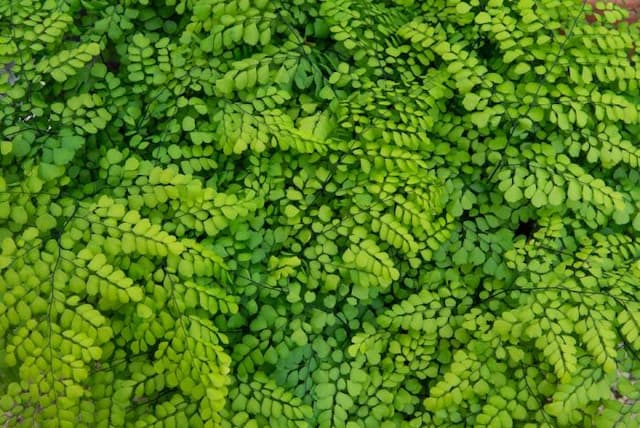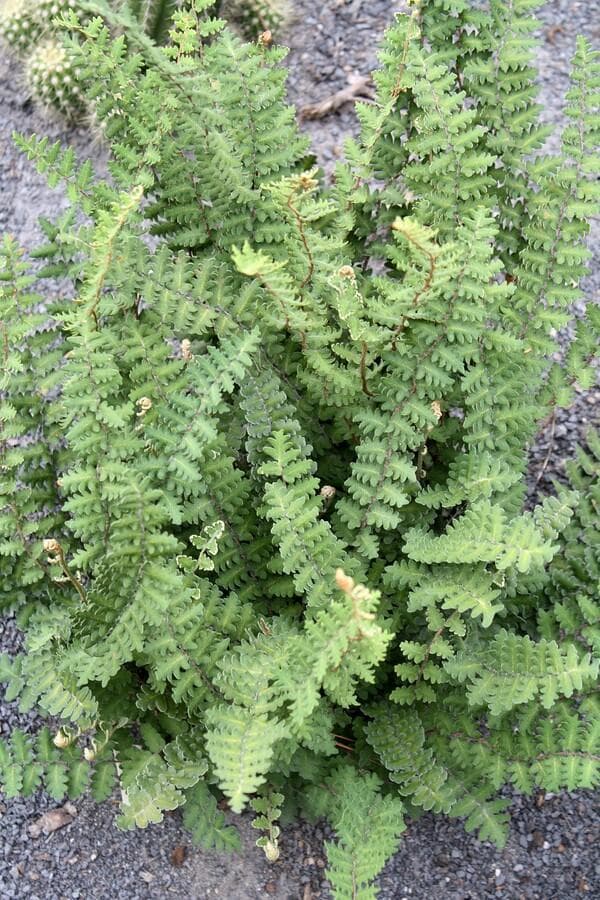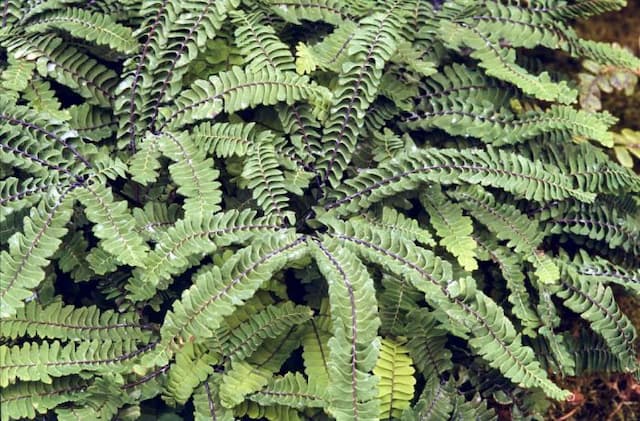Rosy Maidenhair Fern Adiantum hispidulum

ABOUT
Adiantum hispidulum, commonly known as the rough maidenhair fern, presents a distinct and delicate appearance. This charming plant is characterized by its thin, wiry stems that hold an array of small, fan-shaped leaves, known as fronds. These fronds are often a bright, vibrant green, lending a fresh and lively look to the plant. The rough maidenhair fern has a textured look because the fronds bear a slight resemblance to the fine structure of hair. This gives the plant its common name, as "maidenhair" alludes to the gentle, hair-like appearance. The leaves are typically segmented into smaller leaflets, giving the plant an intricate and feathery appearance. Each leaflet is smooth edged, creating a lacy pattern that is pleasing to the eye. In terms of color, the young fronds can sometimes display a pinkish or bronzy hue before they mature to the more familiar green. The overall form of the rough maidenhair fern is one of grace and elegance, with a soft texture that invites touch. It's a plant that enjoys shady spots with indirect light, making it a popular choice for indoor plant enthusiasts or for understory planting in gardens. The appearance of the rough maidenhair fern adds a delicate touch of natural beauty to any space it occupies.
About this plant
 Names
NamesFamily
Pteridaceae.
Synonyms
Rough Maidenhair Fern, Rosy Maidenhair Fern, Five-Finger Fern, Hishiduma.
Common names
Adiantum hispidulum var. typicum, Adiantum incertum, Adiantum majus, Adiantum cubense, Adiantum hispidulum var. rufum, Adiantum hispidulum var. paleaceum, Litobrochia hispidula, Chorisanthes hispidula, Adiantum hispidulum var. obliquum, Adiantum hispidulum var. bipinnatum, Adiantum hispidulum var. decompositum.
 Toxicity
ToxicityTo humans
The plant known as rough maidenhair fern (Adiantum hispidulum) is not considered toxic to humans. There are no well-documented cases of poisoning or adverse effects from ingesting this fern. Therefore, accidental ingestion of the rough maidenhair fern typically does not result in any symptoms of poisoning and is not known to have serious consequences for humans.
To pets
Rough maidenhair fern (Adiantum hispidulum) is also not known to be toxic to pets. Like in humans, ingestion of this plant by pets such as cats and dogs is not expected to cause any significant symptoms of poisoning. There are no specific known toxic consequences associated with pets ingesting any part of the rough maidenhair fern. However, as with any non-food plant, ingestion can sometimes lead to mild gastrointestinal upset simply due to the ingestion of non-digestible plant matter.
 Characteristics
CharacteristicsLife cycle
Perennials
Foliage type
Evergreen
Color of leaves
Green
Height
1-2 feet (30-60 cm)
Spread
1-2 feet (30-60 cm)
Plant type
Fern
Hardiness zones
9
Native area
Australia
Benefits
 General Benefits
General Benefits- Aesthetic Appeal: Adiantum hispidulum, commonly known as Rough Maidenhair Fern, is known for its delicate fronds and attractive texture that can enhance the visual interest of any indoor or garden space.
- Shade Gardening: This plant is well-suited for shady areas in gardens where many other plants may not thrive, thus contributing to plant diversity in those spaces.
- Humidity Lover: Rough Maidenhair Fern enjoys humid conditions, making it a suitable choice for bathrooms or other naturally humid areas of a home.
- Low Maintenance: It is relatively easy to care for as long as its basic requirements of shade and moisture are met, making it a good option for both novice and experienced gardeners.
- Erosion Control: When planted outdoors, the Rough Maidenhair Fern can help in soil stabilization and erosion control due to its spreading nature and the matting of its roots.
- Habitat Creation: As a native fern species in certain regions, it can provide appropriate habitat for a range of local insects and small wildlife as part of an ecological garden or conservation area.
- Cooling Effect: Planted in groups, ferns like Adiantum hispidulum can contribute to the cooling of their immediate surroundings through the process of transpiration and by providing shade.
 Medical Properties
Medical Properties- This plant is not used for medical purposes.
 Air-purifying Qualities
Air-purifying QualitiesThis plant is not specifically known for air purifying qualities.
 Other Uses
Other Uses- Ornamental Display: Adiantum hispidulum, commonly known as the Rough Maidenhair Fern, is often used as a decorative element in shaded gardens or as an elegant centerpiece in floral arrangements.
- Shade Tolerance Indicator: Because the Rough Maidenhair Fern thrives under shaded conditions, its presence can signal suitable locations for planting other shade-loving plants.
- Humidity Indicator: The health and lushness of the Rough Maidenhair Fern can indicate the level of humidity in an area, which can be particularly useful in greenhouses or indoor gardens.
- Botanical Studies: Studying Adiantum hispidulum can provide insights into fern reproductive strategies and spore dispersal mechanisms, due to its distinctive reproductive fronds.
- Educational Tool: This fern can be used in schools or educational programs to teach about plant identification, lifecycle, and the importance of habitat conservation for delicate species.
- Artistic Inspiration: Artists and photographers often use the intricate fronds and delicate appearance of the Rough Maidenhair Fern as subjects in their work, highlighting its aesthetic value.
- Water-Use Efficiency Model: The Rough Maidenhair Fern's ability to thrive in moist environments can be studied to understand how plants use water efficiently, which can inform sustainable landscaping practices.
- Garden Microclimate Regulator: By planting Adiantum hispidulum in a garden, one can create a microclimate with higher moisture levels, potentially benefiting nearby plants that require similar conditions.
- Soil Erosion Control: This fern can help stabilize soil in garden areas and prevent erosion due to its ability to spread and form dense patches under suitable conditions.
- Biophilic Design Element: Integrating Rough Maidenhair Ferns into indoor living spaces or work environments can enhance the biophilic design, which focuses on increasing human connectivity to the natural environment.
Interesting Facts
 Feng Shui
Feng ShuiThe Rough Maidenhair Fern is not used in Feng Shui practice.
 Zodiac Sign Compitability
Zodiac Sign CompitabilityThe Rough Maidenhair Fern is not used in astrology practice.
 Plant Symbolism
Plant Symbolism- Fineness and Delicacy: Also known as the "Rosy Maidenhair Fern," Adiantum hispidulum's feather-light and fine textured fronds symbolize delicacy and a fine nature.
- Purity and Innocence: Maidenhair ferns are often associated with purity and innocence due to their delicate appearance and fresh, lush green color, which is emblematic of new beginnings and pure intentions.
- Secret Bond of Love: In the language of flowers, ferns symbolize secret bonds of love, with the Rosy Maidenhair Fern suggesting a tender and discreet connection.
- Health and Wellness: Ferns, in general, are known to symbolize health and wellness, possibly due to their air-purifying qualities, and the Rosy Maidenhair Fern shares this symbolism, representing an interest in a healthy lifestyle.
- Shelter and Protection: With its ability to grow in shaded areas, Adiantum hispidulum can represent shelter and protection, drawing a parallel between its growing conditions and the provision of a protective haven.
 Water
WaterThe Rosy Maidenhair Fern should be watered thoroughly, allowing the top inch of soil to dry out between waterings. The amount of water needed can vary, but as a general rule, adding approximately 8 to 16 ounces of water every week should be sufficient, though this may need to be adjusted based on the humidity and temperature of the growing environment. Over-watering must be avoided to prevent root rot, so it's crucial to ensure the plant pot has adequate drainage. During the growing season, spring through summer, the plant may require more frequent watering, while in the cooler months, waterings should be reduced as the plant growth slows down.
 Light
LightThe Rosy Maidenhair Fern thrives in bright, indirect light but can tolerate lower light levels. It should not be subjected to direct sunlight, which can scorch the delicate fronds. A north-facing window or a spot that receives diffused light is ideal for this plant, ensuring it receives consistent, gentle light without being exposed to the harsh midday sun. If natural light is low in your home, consider using grow lights to provide sufficient illumination.
 Temperature
TemperatureThe Rosy Maidenhair Fern prefers temperatures between 65°F and 75°F. It is sensitive to cold and should not be exposed to temperatures below 55°F as this can cause damage to the plant. The ideal temperature range promotes healthy growth and maintains the plant's lush appearance. Sudden temperature fluctuations and drafts should also be avoided to keep the fern in its best condition.
 Pruning
PruningPruning the Rosy Maidenhair Fern is generally done to remove any brown or dead fronds to maintain a clean appearance and encourage healthy growth. It should be pruned sparingly, as the plant does not grow back as quickly as some other ferns. The best time to prune is in spring before new growth begins, or as needed throughout the year to remove unsightly or damaged fronds.
 Cleaning
CleaningAs needed
 Soil
SoilRough Maidenhair Fern prefers well-draining, rich organic soil with a pH of 6.0 to 7.5. A mix of peat moss or coco coir, perlite, and compost or worm castings creates an ideal growing medium for this fern.
 Repotting
RepottingRough Maidenhair Fern should be repotted every 1-2 years. Choose a pot that's one size larger and use fresh soil mix to encourage healthy growth.
 Humidity & Misting
Humidity & MistingRough Maidenhair Fern thrives at high humidity levels, around 60% to 80%. Creating a humid environment is key for this fern's well-being.
 Suitable locations
Suitable locationsIndoor
Place Rough Maidenhair Fern in bright, indirect light and ensure high humidity.
Outdoor
Grow in shade and protect from the wind; ensure soil is moist.
Hardiness zone
8-11 USDA
 Life cycle
Life cycleThe life of the Adiantum hispidulum, commonly known as the Rough Maidenhair Fern, begins with the dispersal of its tiny, dust-like spores, released from mature sporangia typically found on the undersides of the fronds. Upon landing in a moist environment, the spores germinate to produce a heart-shaped gametophyte, known as a prothallus, which is the sexual stage. This gametophyte bears both male and female reproductive organs, and after fertilization, the resulting zygote grows into a new sporophyte, the familiar fern plant. The sporophyte's early growth stage is characterized by the unfurling of fronds from a rhizome in a process known as circinate vernation. As the Rough Maidenhair matures, it forms a clump of graceful, arching fronds with branched, wiry black stems and triangular green leaflets. With the right conditions of humidity and shade, the plant will reach reproductive maturity and continue the cycle by producing spores, given that it is a perennial species with the ability to live for several years.
 Propogation
PropogationPropogation time
Spring to Summer
Propogation: The most popular method of propagation for Adiantum hispidulum, commonly known as the Rough Maidenhair Fern, is through division. This process is typically done in the spring or early summer. To propagate by division, carefully remove the fern from its pot and gently separate the clumps into smaller sections, each with several fronds and a portion of the root system. Replant each division into its own pot filled with a well-draining potting mix and keep the soil moist while the new plant establishes itself. Providing high humidity and warmth can encourage faster growth. It's important to be gentle during this process as the fern's roots and fronds are quite delicate. This method of division allows for a quick increase in the number of plants and helps maintain the genetic characteristics of the parent plant.









